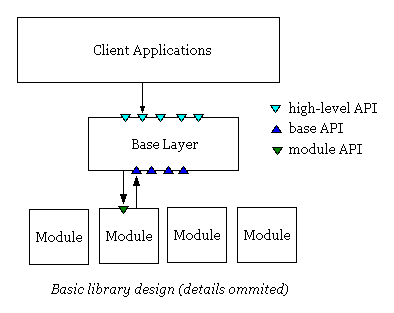It's better to describe FreeType 2 as a collection of
components. Each one of them is a more or less abstract part of
the library that is in charge of one specific task. We will now explicit
the connections and relationships between them.
A first brief description of this system of components could be:
-
Client applications typically call the FreeType 2
high-level API, whose functions are implemented in a single
component called the Base Layer.
-
Depending on the context or the task, the base layer then calls one
or more module components to perform the work. In most
cases, the client application doesn't need to know which module was
called.
-
The base layer also contains a set of routines that are used for
generic things like memory allocation, list processing, i/o stream
parsing, fixed point computation, etc. these functions can also be
called by a module at any time, and they form what is called the
low-level base API.
This is illustrated by the following graphics (note that component
entry points are represented as colored triangles):

Now, a few additional things must be added to complete this
picture:
-
Some parts of the base layer can be replaced for specific builds of
the library, and can thus be considered as components themselves.
This is the case for the ftsystem component, which is in
charge of implementing memory management & input stream access, as
well as ftinit, which is in charge of library initialization
(i.e. implementing the FT_Init_FreeType() function).
-
FreeType 2 comes also with a set of optional
components, which can be used either as a convenience for client
applications (e.g. the ftglyph component, used to provide a
simple API to manage glyph images independently of their internal
representation), or to access format-specific features (e.g. the
ftmm component used to access and manage Multiple Masters
data in Type 1 fonts).
-
Finally, a module is capable of calling functions provided by
another module. This is very useful to share code and tables between
several font driver modules (for example, the truetype and
cff modules both use the routines provided by the
sfnt module).
Hence, a more complete picture would be:

Please take note of the following important points:
-
An optional component can use either the high-level or base API.
This is the case of ftglyph in the above picture.
-
Some optional components can use module-specific interfaces ignored
by the base layer. In the above example, ftmm directly
accesses the Type 1 module to set/query data.
-
A replacable component can provide a function of the high-level
API. For example, ftinit provides
FT_Init_FreeType() to client applications.
|

